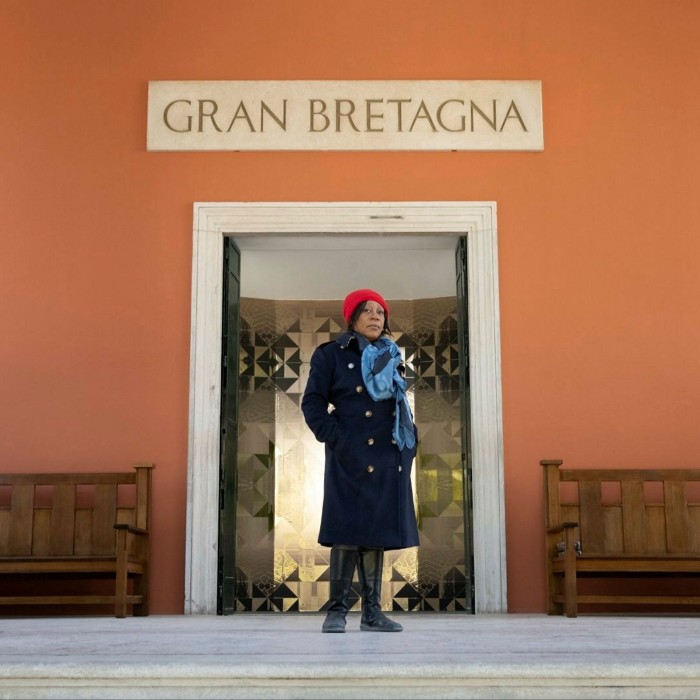The art world’s commercially-minded businesses and publicly funded institutions are increasingly finding common ground. Their newfound collaborative spirit culminated in recent news that the art fair and publishing group Frieze has joined a constellation of sponsors for the British pavilion at the prestigious Venice Biennale next year.
Frieze’s financial support, described as a five-figure sum, will help produce work by next year’s choice, artist and filmmaker John Akomfrah. Frieze’s commitment marks the first time that an art fair has provided funding for any national pavilion, confirms its London director Eva Langret, and highlights the market’s growing desire to be seen supporting art’s broader landscape.
“One of the silver linings of the Covid-19 pandemic is that we had no choice but to pull together,” says Langret. “There’s now a stronger sense of community, and the psychological barriers are coming down.”

For the British Council, which has organised the pavilion since 1937, the need for extra support is clear. The Venice Biennale, described by the British Council’s director of arts, Skinder Hundal, as “the Oscars for contemporary art”, does not come cheap. Artists are asked on a relatively short timeframe to fill their country’s pavilions, which in the case of Britain’s encompasses six exhibition spaces. The show can prove career-defining.
Funding-wise, Hundal says that “one third of our money comes from the government, the rest we have to find”. Its backers for 2024 include headline partner Burberry, the collector Shane Akeroyd (whose brother is chief executive of the fashion brand), the UK’s Art Fund and America’s Ford Foundation. As well as Frieze, market support comes from Christie’s — which first sponsored the pavilion for its Golden Lion-winning year of 2022 — and Lisson Gallery, which represents Akomfrah.
Hundel describes all private supporters as “super-enthusiastic, with energy, optimism and purpose and a real interest in art and artists”. They are also all uncontentious — and necessary. While the pavilion’s government funding level is similar to 2022, he says, costs for materials and shipping for the event’s 60th edition have soared. And though the details of Akomfrah’s installation are under wraps, it is “ambitious, even audacious”, Hundel says, adding, “We have to work a little harder.”


The immediate financial benefits to Frieze are less obvious, though the London-founded business has a vested interest in maximising the creative advantages of its home turf, not least as Paris begins to compete as an art market centre. For Frieze’s loyal UK exhibitors and supporters, a commitment to the British pavilion might also assuage any concerns that the art-fair group — which has doubled its events in the US this year and has been majority-owned by the Hollywood entertainment conglomerate Endeavor since 2016 — has its eye elsewhere.
Langret sees it more as a continuation of the group’s ongoing support of the UK’s cultural institutions, stepped up for its 20th anniversary this year. This includes the Camden Art Centre and, through the Contemporary Art Society, several museums across the UK. “The difference this time is that it is about putting UK art on an international stage,” she says.
The Venice Biennale, ostensibly a non-commercial extravaganza, can swiftly raise an artist’s prices as well as their reputation, so it is no stranger to the commercial sector. Gallerists turn up in force at the event’s opening and generally provide financial support for their artists on show. They are not meant to sell anything from inside the pavilions during the seven-month run, though rewards can still be immediate. “See it in Venice, buy it in Basel” is the refrain about the practice of selling other works by Biennale artists at coinciding art fairs — though now that Venice opens earlier in the spring, perhaps Frieze New York is more pertinent.

Hundal says that the British Council guidelines are clear with all its supporters: “They know they can’t curate the pavilion or tell artists what to do,” he says. In terms of any on-site selling, he says that “nobody has ever raised the issue.”
Once the Venice Biennale is over, though, anything goes. But the simple show-then-sell equation underestimates the role a gallery plays in its artists’ careers, says Louise Hayward, partner at Lisson. She accepts that a gallery needs to sell but describes its job as “just like an agent with a musician, to find partners, supporters and collaborations — say, with fashion brands — to help an artist make the work they want to make”. Then, she says, “one thing every gallery should do is make sure that the work is seen,” adding that their priority after the Biennale is to get Akomfrah’s installation in front of UK audiences.
Like many in the market at the moment, Hayward talks of the cultural landscape as “a whole ecosystem” and underlines “public engagement”. An increasingly philanthropic bent reveals itself in other areas. For this week’s Art Basel Miami Beach fair, organisers have launched an online selling platform for 15 of the works on show, priced up to $285,000, for which buyers are asked to donate a minimum 10 per cent to one of two charities. Its website, developed by Arcual, helpfully does the maths for you and the fair group has given a $25,000 donation to kick-start the process. The initiative, notes Noah Horowitz, Art Basel’s chief executive, has the additional advantage that artists and their galleries, who are often called upon to donate works to charitable events, “still get their share”.


Market support is not completely altruistic. This data behind this year’s Hiscox Online Art Trade Report found that “social impact/patronage (supporting artists, arts organisations)” was the second most important motivation for buying art, after “emotional benefits”, among its surveyed collectors under the age of 35. Another recent report, by Deloitte and ArtTactic, concluded similarly that “social impact investment” was a priority for 66 per cent of its younger demographic of buyers (versus 24 per cent of collectors overall). Next-generation collectors are “increasingly engaged with systemic issues like climate change and wealth inequality”, this report said. The logical conclusion is that if the commercial sector doesn’t get on board, it will struggle to keep relevant.
The optics remain tricky for arts organisations, a low priority in government decision-making while hospitals suffer and wars rage. In the UK, for example, cultural institutions face funding cuts and, around the world, the cost of living crisis has hit artists and emerging gallerists hard. Frieze’s Langret acknowledges that the wider economic backdrop has become tougher but, she says, “We are not stepping in to replace government funding, we just have a role to play.” She identifies an immediate fluidity between the fair’s commercial and institutional projects: “Everything that happens inside the tents can only be successful if the wider ecosystem is successful.”
Stay connected with us on social media platform for instant update click here to join our Twitter, & Facebook
We are now on Telegram. Click here to join our channel (@TechiUpdate) and stay updated with the latest Technology headlines.
For all the latest Art-Culture News Click Here
